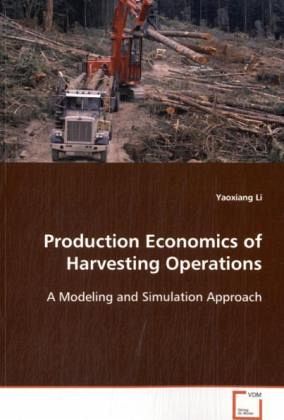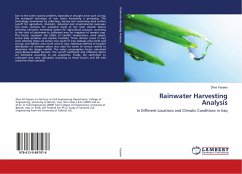
Production Economics of Harvesting Operations
A Modeling and Simulation Approach
Versandkostenfrei!
Versandfertig in 6-10 Tagen
45,99 €
inkl. MwSt.

PAYBACK Punkte
23 °P sammeln!
Because of the species diversity, varied site conditions and growth rates, it is really challenging to manage the central Appalachian hardwoods. Examining the harvesting techniques and interactions among stands, harvests, and machines is becoming a concern to the researchers in the region.This book, therefore, provides a modeling and simulation approach to aid these efforts by estimating the productivity, cost, and traffic intensity of different harvesting configurations under a variety of harvesting prescriptions and stand conditions. A three-dimensional stand generator was described in the b...
Because of the species diversity, varied site
conditions and growth rates, it is really
challenging to manage the central Appalachian
hardwoods. Examining the harvesting techniques and
interactions among stands, harvests, and machines is
becoming a concern to the researchers in the region.
This book, therefore, provides a modeling and
simulation approach to aid these efforts by
estimating the productivity, cost, and traffic
intensity of different harvesting configurations
under a variety of harvesting prescriptions and
stand conditions. A three-dimensional stand
generator was described in the book, which can be
used to visualize the stand structure and
composition of hardwood stands and perform dynamic
analyses of various management prescriptions.
Algorithms for felling and skidding operations were
modeled mathematically. Three commonly used
harvesting systems were modeled and simulated on
five generated stands of different ages in the book.
Five harvest methods were examined. This book will
be of interest to loggers, landowner, forest
managers, and students and researchers in forest
operations and timber harvesting.
conditions and growth rates, it is really
challenging to manage the central Appalachian
hardwoods. Examining the harvesting techniques and
interactions among stands, harvests, and machines is
becoming a concern to the researchers in the region.
This book, therefore, provides a modeling and
simulation approach to aid these efforts by
estimating the productivity, cost, and traffic
intensity of different harvesting configurations
under a variety of harvesting prescriptions and
stand conditions. A three-dimensional stand
generator was described in the book, which can be
used to visualize the stand structure and
composition of hardwood stands and perform dynamic
analyses of various management prescriptions.
Algorithms for felling and skidding operations were
modeled mathematically. Three commonly used
harvesting systems were modeled and simulated on
five generated stands of different ages in the book.
Five harvest methods were examined. This book will
be of interest to loggers, landowner, forest
managers, and students and researchers in forest
operations and timber harvesting.












